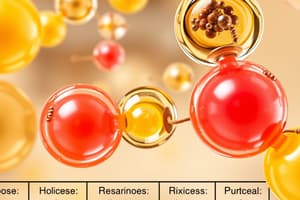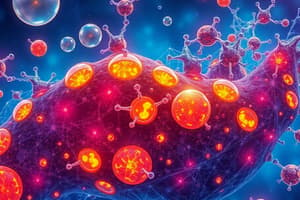Podcast
Questions and Answers
What is the general formula for fatty acids?
What is the general formula for fatty acids?
- C_nH_2n+1COOH (correct)
- C_nH_2nCOOH
- C_nH_2n+3COOH
- C_nH_2n+2COOH
Which statement about fatty acids is correct?
Which statement about fatty acids is correct?
- Fatty acids are exclusively hydrophobic compounds.
- Even number straight chain fatty acids are rare in nature.
- Unsaturated fatty acids contain no double bonds in their chain.
- Odd-numbered fatty acids are found abundantly in ruminant fat. (correct)
What defines a saturated fatty acid?
What defines a saturated fatty acid?
- It contains multiple double bonds.
- It is derived only from plants.
- It has no double bonds. (correct)
- It has one double bond.
Which of the following fatty acids is classified as a monoethanoid acid?
Which of the following fatty acids is classified as a monoethanoid acid?
What is a characteristic of unsaturated fatty acids?
What is a characteristic of unsaturated fatty acids?
How do unsaturated fatty acids generally affect melting points?
How do unsaturated fatty acids generally affect melting points?
Which statement best describes the storage locations of saturated and unsaturated fatty acids?
Which statement best describes the storage locations of saturated and unsaturated fatty acids?
What is the primary reason for the lower oxidative rancidity of saturated fatty acids?
What is the primary reason for the lower oxidative rancidity of saturated fatty acids?
What is the primary role of triacylglycerol in the body?
What is the primary role of triacylglycerol in the body?
Which lipid classification refers to compounds such as phospholipids and glycolipids?
Which lipid classification refers to compounds such as phospholipids and glycolipids?
Which of the following statements about triacylglycerol is false?
Which of the following statements about triacylglycerol is false?
What is the energy yield of triacylglycerol per gram compared to carbohydrates?
What is the energy yield of triacylglycerol per gram compared to carbohydrates?
What percentage of total dietary lipids do triacylglycerols constitute?
What percentage of total dietary lipids do triacylglycerols constitute?
What process involves the breakdown of triacylglycerol to produce free glycerol and fatty acids?
What process involves the breakdown of triacylglycerol to produce free glycerol and fatty acids?
Which of the following is a derived lipid?
Which of the following is a derived lipid?
What critical function do fats serve in the body regarding vitamins A, D, E, and K?
What critical function do fats serve in the body regarding vitamins A, D, E, and K?
Which enzyme is responsible for adding cis double bonds to fatty acids in the endoplasmic reticulum?
Which enzyme is responsible for adding cis double bonds to fatty acids in the endoplasmic reticulum?
Which statement about the conversion of stearic acid to oleic acid is true?
Which statement about the conversion of stearic acid to oleic acid is true?
What occurs during partial hydrogenation of unsaturated fatty acids?
What occurs during partial hydrogenation of unsaturated fatty acids?
Which property is NOT associated with trans fats?
Which property is NOT associated with trans fats?
What is the primary effect of oxidative rancidity in unsaturated oils?
What is the primary effect of oxidative rancidity in unsaturated oils?
Which of the following lipids functions as a carrier of fat-soluble vitamins?
Which of the following lipids functions as a carrier of fat-soluble vitamins?
During hydrogenation, which catalyst is commonly used to convert unsaturated fatty acids into saturated fatty acids?
During hydrogenation, which catalyst is commonly used to convert unsaturated fatty acids into saturated fatty acids?
Which of the following lipid functions is primarily related to energy storage?
Which of the following lipid functions is primarily related to energy storage?
What role do dietary sphingolipids play in the body?
What role do dietary sphingolipids play in the body?
Which statement accurately describes glycolipids?
Which statement accurately describes glycolipids?
How is cholesterol acquired by the body?
How is cholesterol acquired by the body?
What is the primary function of bile salts in the digestive system?
What is the primary function of bile salts in the digestive system?
What distinguishes cholesterol in terms of its presence in different organisms?
What distinguishes cholesterol in terms of its presence in different organisms?
What is the primary function of High Density Lipoprotein (HDL)?
What is the primary function of High Density Lipoprotein (HDL)?
Which statement correctly describes Low Density Lipoproteins (LDL)?
Which statement correctly describes Low Density Lipoproteins (LDL)?
What characterizes Chylomicrons among the different types of lipoproteins?
What characterizes Chylomicrons among the different types of lipoproteins?
What type of lipoprotein is synthesized by the liver to deliver triacylglycerol?
What type of lipoprotein is synthesized by the liver to deliver triacylglycerol?
Which of the following is a source of cholesterol production in the body?
Which of the following is a source of cholesterol production in the body?
What is the primary source of dietary lipids transported by the lymphatic system?
What is the primary source of dietary lipids transported by the lymphatic system?
Which lipoprotein is associated with a lower risk of cardiovascular diseases?
Which lipoprotein is associated with a lower risk of cardiovascular diseases?
What condition is characterized by the overproduction of cholesterol?
What condition is characterized by the overproduction of cholesterol?
What is a biological role of terpenoids in animals?
What is a biological role of terpenoids in animals?
Which of the following is NOT a common use for plant terpenoids?
Which of the following is NOT a common use for plant terpenoids?
How are eicosanoids different from traditional hormones?
How are eicosanoids different from traditional hormones?
Which fatty acids are the precursors for the formation of arachidonic acid?
Which fatty acids are the precursors for the formation of arachidonic acid?
What characteristic distinguishes terpenoids from other organic chemicals?
What characteristic distinguishes terpenoids from other organic chemicals?
Flashcards
Saturated fatty acids
Saturated fatty acids
A type of fatty acid with no double bonds in its hydrocarbon chain. They are typically solid at room temperature.
Unsaturated fatty acids
Unsaturated fatty acids
A type of fatty acid with one or more double bonds in its hydrocarbon chain. They are typically liquid at room temperature.
Monoethanoid acid
Monoethanoid acid
The fatty acid group that contains only one double bond in the hydrocarbon chain.
Diethanoid acid
Diethanoid acid
Signup and view all the flashcards
Triethanoid acid
Triethanoid acid
Signup and view all the flashcards
Essential Fatty Acids (EFAs)
Essential Fatty Acids (EFAs)
Signup and view all the flashcards
Cis Fatty Acids
Cis Fatty Acids
Signup and view all the flashcards
Straight Chain Fatty Acids
Straight Chain Fatty Acids
Signup and view all the flashcards
Hydrogenation
Hydrogenation
Signup and view all the flashcards
Trans Fat
Trans Fat
Signup and view all the flashcards
Halogenation
Halogenation
Signup and view all the flashcards
Oxidative Rancidity
Oxidative Rancidity
Signup and view all the flashcards
Desaturation
Desaturation
Signup and view all the flashcards
Energy Storage
Energy Storage
Signup and view all the flashcards
Membrane Structure
Membrane Structure
Signup and view all the flashcards
Absorption and Transport
Absorption and Transport
Signup and view all the flashcards
Dietary Sphingolipids
Dietary Sphingolipids
Signup and view all the flashcards
Glycolipids
Glycolipids
Signup and view all the flashcards
Glycolipids in Membranes
Glycolipids in Membranes
Signup and view all the flashcards
Cholesterol
Cholesterol
Signup and view all the flashcards
Bile Salts and Chylomicrons
Bile Salts and Chylomicrons
Signup and view all the flashcards
Where is cholesterol synthesized?
Where is cholesterol synthesized?
Signup and view all the flashcards
What are lipoproteins?
What are lipoproteins?
Signup and view all the flashcards
What is the role of HDL?
What is the role of HDL?
Signup and view all the flashcards
What is the role of LDL?
What is the role of LDL?
Signup and view all the flashcards
What is the function of VLDL?
What is the function of VLDL?
Signup and view all the flashcards
What are lipids?
What are lipids?
Signup and view all the flashcards
What are triacylglycerols?
What are triacylglycerols?
Signup and view all the flashcards
What is the primary role of triacylglycerols in the body?
What is the primary role of triacylglycerols in the body?
Signup and view all the flashcards
How do triacylglycerols affect the body's insulation and organ protection?
How do triacylglycerols affect the body's insulation and organ protection?
Signup and view all the flashcards
How do triacylglycerols interact with water?
How do triacylglycerols interact with water?
Signup and view all the flashcards
How do triacylglycerols contribute to the body's energy needs?
How do triacylglycerols contribute to the body's energy needs?
Signup and view all the flashcards
How are triacylglycerols broken down in the body?
How are triacylglycerols broken down in the body?
Signup and view all the flashcards
How are triacylglycerols acquired in the body?
How are triacylglycerols acquired in the body?
Signup and view all the flashcards
Dietary lipids
Dietary lipids
Signup and view all the flashcards
HDLs and LDLs
HDLs and LDLs
Signup and view all the flashcards
High LDL levels
High LDL levels
Signup and view all the flashcards
Familial Hypercholesterolemia
Familial Hypercholesterolemia
Signup and view all the flashcards
Xanthomatosis
Xanthomatosis
Signup and view all the flashcards
Terpenoids
Terpenoids
Signup and view all the flashcards
Eicosanoids
Eicosanoids
Signup and view all the flashcards
Study Notes
Lipid Chemistry
- Lipids are a diverse group of hydrophobic molecules.
- Fatty acids have the general formula CnH2n + 1COOH.
- "Free" fatty acids are not attached to other molecules.
- Fatty acids are amphipathic molecules, with a hydrophilic carboxylic group and a hydrophobic aliphatic tail.
- Even-numbered straight-chain fatty acids are prevalent in plants and animals.
- Odd-numbered and branched-chain fatty acids are synthesized by bacteria, contributing to ruminant animal fat.
- Saturated fatty acids have no double bonds in their hydrocarbon chain.
- Unsaturated fatty acids contain one or more double bonds.
- Unsaturated fatty acids can be classified by the degree of unsaturation (monoenoic, dienoic, trienoic).
- Essential fatty acids (EFAs) must be obtained from the diet.
- Unsaturated fatty acids have lower melting points than saturated fatty acids due to cis double bonds disrupting packing.
Saturated Fatty Acids
- Examples include palmitic acid (C16) and stearic acid (C18).
- Common sources include animal and plant fats.
Unsaturated Fatty Acids
- Sources include plant oils like olive oil, flaxseed oil, and others.
- Common examples include oleic acid (monoenoic) and linoleic acid (dienoic).
- Essential fatty acids (EFAs) are unsaturated fatty acids necessary for various bodily functions.
- Polyunsaturated fatty acids (PUFAs) are unsaturated fatty acids with multiple double bonds in their hydrocarbon chain.
- Hydrogenation is a process used to convert unsaturated fatty acids into saturated fatty acids.
- Partial hydrogenation can result in the formation of trans fats.
Chemical Properties of Fatty Acids
- Hydrogenation of unsaturated fatty acids produces saturated fatty acids and can produce trans fats.
- Halogens (Br₂ and I₂) can be added to unsaturated fatty acids at room temperature, in an acetic acid medium.
- This is used in the iodine number determination.
- Fatty acids can be oxidized with ozone to yield a mixture of aldehydes.
- Fatty acids can also be oxidized with KMnO4 to cleave the molecule at the double bond.
- Oxidation reactions are essential in establishing the position of double bonds.
- Unsaturated fatty acids are more prone to oxidative rancidity, causing off odors and tastes in fats.
Properties of Fatty Acids
- Fatty acids are important energy sources, yielding large amounts of ATP upon metabolism.
- Many cell types utilize glucose or fatty acids for energy, with the heart and skeletal muscle prioritizing fatty acids.
- The body can desaturate fatty acids.
Simple Lipids: Triacylglycerols
- Triacylglycerols are the most abundant lipids, making up 98% of dietary lipids.
- They are major components of fat storage in animals and plants (adipocytes), serving as a concentrated energy store.
- The glycerol backbone is attached to three fatty acid chains via esterification reactions.
Waxes
- Waxes are typically esters of long-chain fatty acids and long-chain alcohols and provide waterproofing.
- Vertebrates secrete waxes to lubricate and waterproof skin.
Compound Lipids
- Phospholipids are the most abundant membrane lipids.
- They have a glycerol backbone esterified to two fatty acids and a phosphate group.
- A polar head group (like choline) is attached to the phosphate group.
- They form bilayers in cell membranes due to their hydrophobic tails and hydrophilic heads.
- Phospholipids assist in the transport of nutrients and waste into and out of cells.
Lecithin
- Lecithin is a phospholipid found in various tissues, particularly in nervous and glandular tissues.
- It helps in the transport and utilization of lipids.
- It plays a role in emulsifying fats in the bloodstream.
Sphingolipids
- Sphingolipids have a sphingosine backbone with fatty acids attached via amide bonds and polar head groups.
- Sphingolipids are essential components of nerve tissues, like myelin sheaths, and may also function in cellular signaling.
Sphingomyelins
- Sphingomyelins are specialized sphingolipids found in myelin sheaths and play a role in electrical signal insulation and transmission.
- A lack of appropriate enzymes to break down sphingomyelins can lead to diseases like Niemann-Pick Disease.
Glycolipids
- Glycolipids comprise lipids that have carbohydrate group attachments.
- Glycolipids are important components of cell membranes, especially critical for the outer surface of nerve cells and chloroplast membranes.
- They form self-sealing lipid bilayers, a fundamental structure in cell membranes.
Derived Lipids: Steroids
- Steroids, like cholesterol, are derived from the basic structure.
- Cholesterol is vital for cell membrane fluidity and is a precursor for many steroids, such as hormones (e.g., testosterone, estrogen) and bile acids.
- cholesterol is an important component of cell membranes and precursor of many other biologically important steroid compounds.
- Lipoproteins transport cholesterol in the bloodstream.
Lipoproteins
- Cholesterol and other lipids are transported in the bloodstream as lipoprotein complexes.
- Different types of lipoproteins exist (HDL, LDL, VLDL, and chylomicrons).
- Different types of lipoproteins have differing roles in transporting lipids and regulating cellular lipid concentrations.
Terpenoids
- Terpenoids are a large group of naturally occurring organic compounds, often found in plants, involved in aromatic qualities, fragrances, medicinal properties.
- Many terpenoids serve as precursors for biologically important compounds such as steroids and other hormones.
- Essential oils are rich in terpenoids.
Eicosanoids
- Eicosanoids are derived from fatty acids and function as hormones, acting as local signals.
- They are involved in complex biological control mechanisms, including inflammation, immune responses, and other important cellular functions.
- Prostaglandins, thromboxanes, and leukotrienes are examples of eicosanoids.
- Eicosanoids are not stored but are rapidly metabolized to inactive products.
Studying That Suits You
Use AI to generate personalized quizzes and flashcards to suit your learning preferences.




